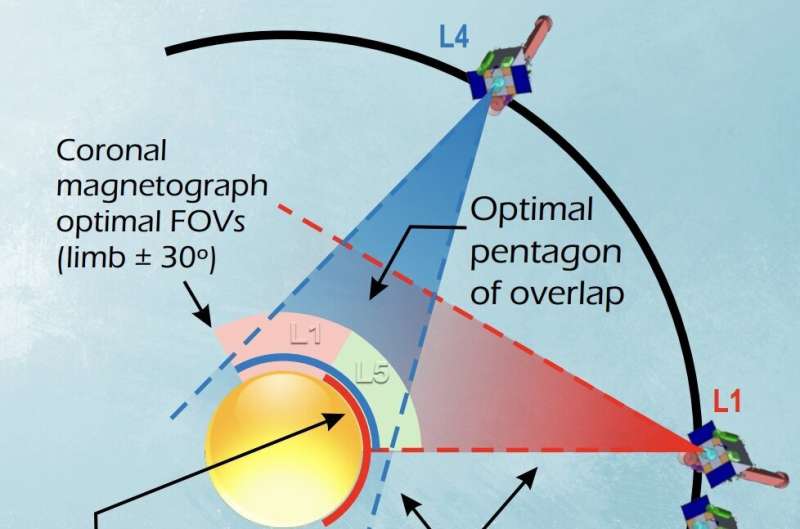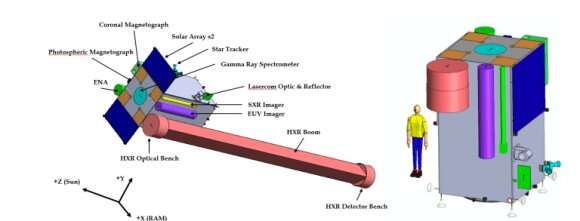The sun reaches solar maximum in 2032: A new NASA flagship mission could give us a perfect view

There are always more space missions than there is money to support them. Ultimately, some make the cut, and some do not. Various factors go into that decision, though those factors can change over the years and decades that some of these missions are designed to take.
But the more ideas, the better, and now a new idea has sprung up from a group of scientists at SWRI, NASA, and the University of Minnesota, among others. It involves four different probes sent to various points in the solar system to observe the sun as it has never been seen before—and just in time to see its most spectacular display in 2032.
The mission, called COMPLETE (which does not appear to be an acronym), would send satellites to several different Lagrange points in the Earth-sun system. L4 and L5 (the trailing and leading Lagrange points) would each get one probe, and L1, which is much closer to Earth, would get two. Each of these probes could be launched on a Falcon Heavy rocket sometime near 2032, the expected height of the next 11-year solar cycle.
As that cycle kicks off, COMPLETE mission controllers would be able to observe it in unprecedented resolution. Each probe would have a spectrograph to capture regular light and a magnetograph to detect magnetic fields associated with coronal mass ejections and other phenomena emanating from the sun.
One of the significant considerations for which missions are selected is cost, and having four different probes for a single mission would increase COMPLETE’s cost. That is especially true as each probe is expected to be large—much larger than a typical human. So the team behind it decided it was essential to use probes that already have “heritage,” as it is called in the jargon—meaning they were developed for a different mission and don’t need expensive development efforts themselves. They can just be integrated into the probe design and with each other.

Those sensors will be needed to answer four primary questions about the magnetic and other types of energy released during impulsive phenomena on the sun. To answer those questions, the design team realized they needed sensors in several different wavelengths, including extreme ultraviolet, X-rays, and gamma rays. Luckily, sensors for each of those wavelengths were already developed for other missions.
Unfortunately, there was one area where the team couldn’t get away with piggybacking on technologies developed for other missions—data transfer. NASA’s Deep Space Network, the most common way to communicate with probes beyond Earth’s orbit, is two orders of magnitude too slow to communicate all the data COMPLETE’s probes will be collecting.
NASA already has plans in the works for an optical communication system that the agency plans to release by 2035. However, they would be slightly too late to make use of for the expected 2032 solar maximum, and thereby the main focal point of the mission. As such, the COMPLETE team suggested putting some more funding into pushing up the timeline of that optical communication system so that not only COMPLETE but other deep-space missions could benefit from it in that timeframe.
So with all the heritage hardware and needed updates to worldwide communications infrastructure, what about the final number? The project team provides two different estimates for the mission, ranging from $2.1B to $2.5 billion. That level puts it in the “Flagship” class of missions, the determination of which is primarily based on the expected cost of the mission.
Unfortunately, there can only be a small number of Flagship missions being actively worked upon at any one time, and COMPLETE has yet to receive that recognition from any funding agency, including NASA. However, the paper describing the mission was presented to the Heliophysics Decadal survey team and is freely available for those interested. It might become a reality someday with enough support from funding agencies or the private sphere.
The research is published on the arXiv preprint server.
More information:
Amir Caspi et al, COMPLETE: A flagship mission for complete understanding of 3D coronal magnetic energy release, arXiv (2023). DOI: 10.48550/arxiv.2305.16533
Citation:
The sun reaches solar maximum in 2032: A new NASA flagship mission could give us a perfect view (2023, June 12)
retrieved 13 June 2023
from https://phys.org/news/2023-06-sun-solar-maximum-nasa-flagship.html
This document is subject to copyright. Apart from any fair dealing for the purpose of private study or research, no
part may be reproduced without the written permission. The content is provided for information purposes only.
For all the latest Science News Click Here
For the latest news and updates, follow us on Google News.

